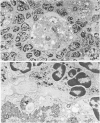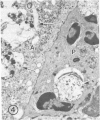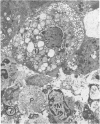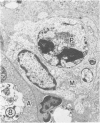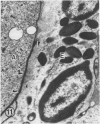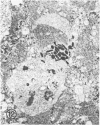Abstract
One of the hallmarks of tissue necrosis produced by the human protozoan parasite Entamoeba histolytica, the causative agent of human amebiasis, appeared to be the lack of inflammatory reaction to the invading trophozoites. Recent evidence suggests, however, that inflammatory cells do appear during early stages of amebic destructive lesions and that they contribute to the establishment of foci of tissue necrosis in intestinal and liver lesions. The present analysis of the fine-structural changes that take place during early stages of amebic liver abscesses induced in hamsters after the intraportal inoculation of axenic amebas has shown that large numbers of polymorphonuclear leukocytes (PMNs) are recruited around invading amebas. These leukocytes lyse as a consequence of contact-mediated damage induced by the trophozoites. Amebas were also capable of ingesting apparently intact PMNs. Macrophages and eosinophils were also recruited at the foci of inflammation. At all times examined, trophozoites of Entamoeba histolytica survived in spite of being in close contact with PMNs or degranulating eosinophils. The ultrastructural observations have also shown the lack of direct contact between amebas and liver parenchymal cells during the initial stages of the focal liver necrosis induced by the parasite, therefore supporting the view that hepatic damage may be effected indirectly through lysis of inflammatory cells. The results also provide a basis for the understanding of the induction of experimental protective immunity against invasive amebiasis, a process which seems to be mostly dependent on cellular mechanisms.
Full text
PDF


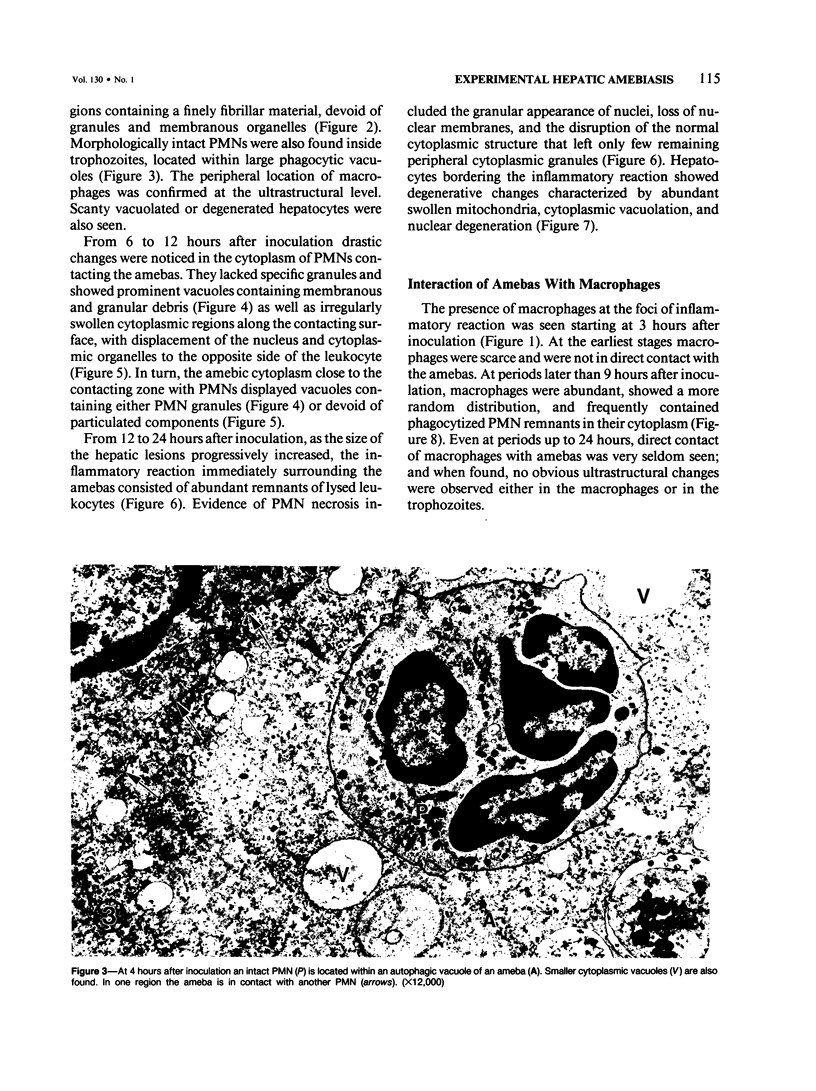

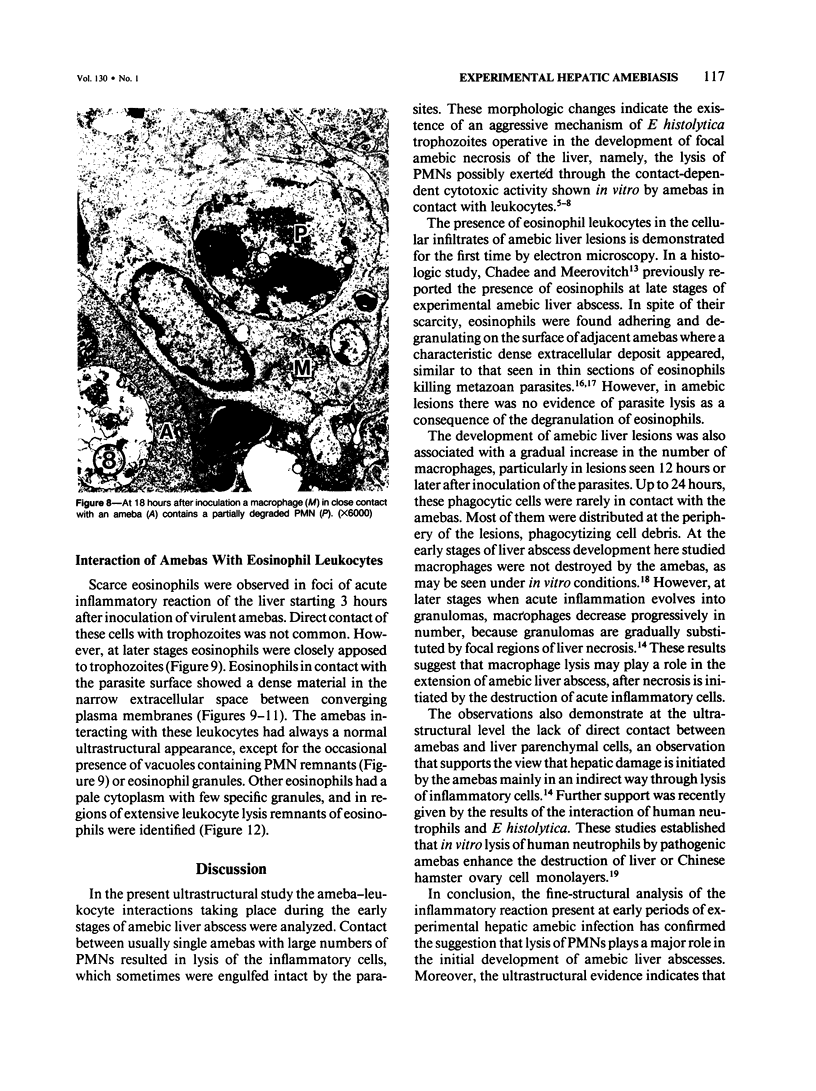

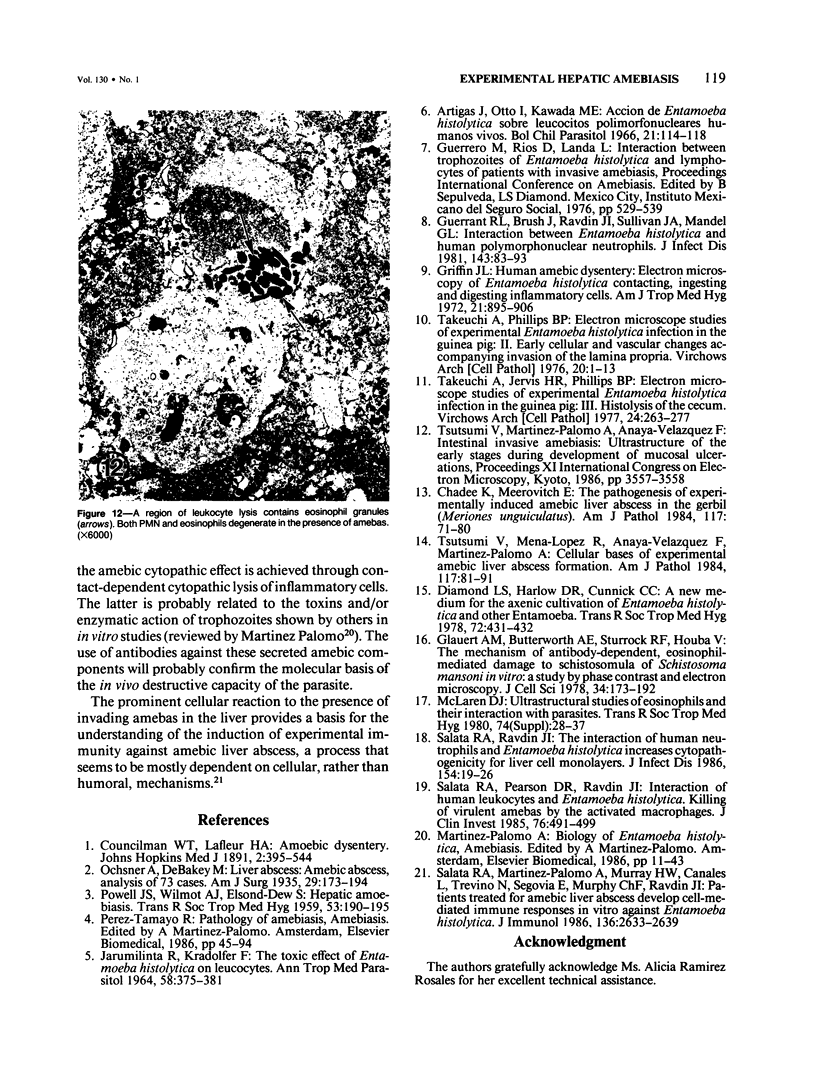
Images in this article
Selected References
These references are in PubMed. This may not be the complete list of references from this article.
- Artigas J., Otto I., Kawada M. E. Acción de Entamoeba histolytica sobre leucocitos polimorfonucleares humanos vivos. Bol Chil Parasitol. 1966 Oct-Dec;21(4):114–118. [PubMed] [Google Scholar]
- Chadee K., Meerovitch E. The pathogenesis of experimentally induced amebic liver abscess in the gerbil (Meriones unguiculatus). Am J Pathol. 1984 Oct;117(1):71–80. [PMC free article] [PubMed] [Google Scholar]
- Diamond L. S., Harlow D. R., Cunnick C. C. A new medium for the axenic cultivation of Entamoeba histolytica and other Entamoeba. Trans R Soc Trop Med Hyg. 1978;72(4):431–432. doi: 10.1016/0035-9203(78)90144-x. [DOI] [PubMed] [Google Scholar]
- Glauert A. M., Butterworth A. E., Sturrock R. F., Houba V. The mechansim of antibody-dependent, eosinophil-mediated damage to schistosomula of Schistosoma mansoni in vitro: a study by phase-contrast and electron microscopy. J Cell Sci. 1978 Dec;34:173–192. doi: 10.1242/jcs.34.1.173. [DOI] [PubMed] [Google Scholar]
- Griffin J. L. Human amebic dysentery. Electron microscopy of Entamoeba histolytica contacting, ingesting, and digesting inflammatory cells. Am J Trop Med Hyg. 1972 Nov;21(6):895–906. [PubMed] [Google Scholar]
- Guerrant R. L., Brush J., Ravdin J. I., Sullivan J. A., Mandell G. L. Interaction between Entamoeba histolytica and human polymorphonuclear neutrophils. J Infect Dis. 1981 Jan;143(1):83–93. doi: 10.1093/infdis/143.1.83. [DOI] [PubMed] [Google Scholar]
- JARUMILINTA R., KRADOLFER F. THE TOXIC EFFECT OF ENTAMOEBA HISTOLYTICA ON LEUCOCYTES. Ann Trop Med Parasitol. 1964 Sep;58:375–381. doi: 10.1080/00034983.1964.11686259. [DOI] [PubMed] [Google Scholar]
- POWELL S. J., WILMOT A. J., ELSDONDEW R. Hepatic amoebiasis. Trans R Soc Trop Med Hyg. 1959 Mar;53(2):190–195. doi: 10.1016/0035-9203(59)90070-7. [DOI] [PubMed] [Google Scholar]
- Salata R. A., Martinez-Palomo A., Murray H. W., Conales L., Trevino N., Segovia E., Murphy C. F., Ravdin J. I. Patients treated for amebic liver abscess develop cell-mediated immune responses effective in vitro against Entamoeba histolytica. J Immunol. 1986 Apr 1;136(7):2633–2639. [PubMed] [Google Scholar]
- Salata R. A., Pearson R. D., Ravdin J. I. Interaction of human leukocytes and Entamoeba histolytica. Killing of virulent amebae by the activated macrophage. J Clin Invest. 1985 Aug;76(2):491–499. doi: 10.1172/JCI111998. [DOI] [PMC free article] [PubMed] [Google Scholar]
- Salata R. A., Ravdin J. I. The interaction of human neutrophils and Entamoeba histolytica increases cytopathogenicity for liver cell monolayers. J Infect Dis. 1986 Jul;154(1):19–26. doi: 10.1093/infdis/154.1.19. [DOI] [PubMed] [Google Scholar]
- Takeuchi A., Jervis H. R., Phillips B. P. Electron microscope studies of experimental Entamoeba histolytica infection in the guinea pig. III. Histolysis of the cecum. Virchows Arch B Cell Pathol. 1977 Sep 15;24(4):263–277. doi: 10.1007/BF02889285. [DOI] [PubMed] [Google Scholar]
- Takeuchi A., Phillips B. P. Electron microscope studies of experimental Entamoeba histolytica infection in the guinea pig. II. Early cellular and vascular changes accompanying invasion of the lamina propria. Virchows Arch B Cell Pathol. 1976 Feb 11;20(1):1–13. doi: 10.1007/BF02890322. [DOI] [PubMed] [Google Scholar]
- Tsutsumi V., Mena-Lopez R., Anaya-Velazquez F., Martinez-Palomo A. Cellular bases of experimental amebic liver abscess formation. Am J Pathol. 1984 Oct;117(1):81–91. [PMC free article] [PubMed] [Google Scholar]



